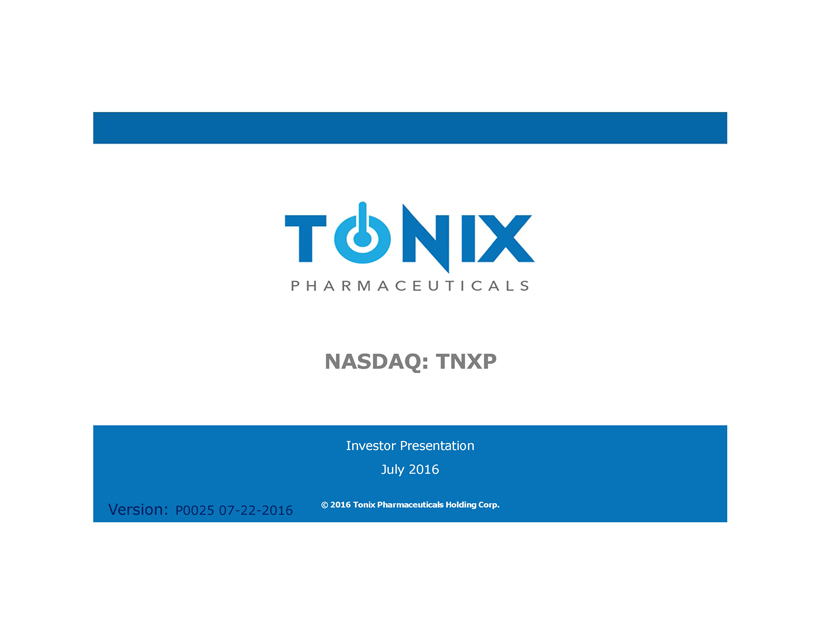
Exhibit 99.01

© Copyright 2016 Tonix Pharmaceuticals - Confidential - Do not duplicate or distribute NASDAQ: TNXP Investor Presentation July 2016 © 2016 Tonix Pharmaceuticals Holding Corp. Version: P0025 07 - 22 - 2016
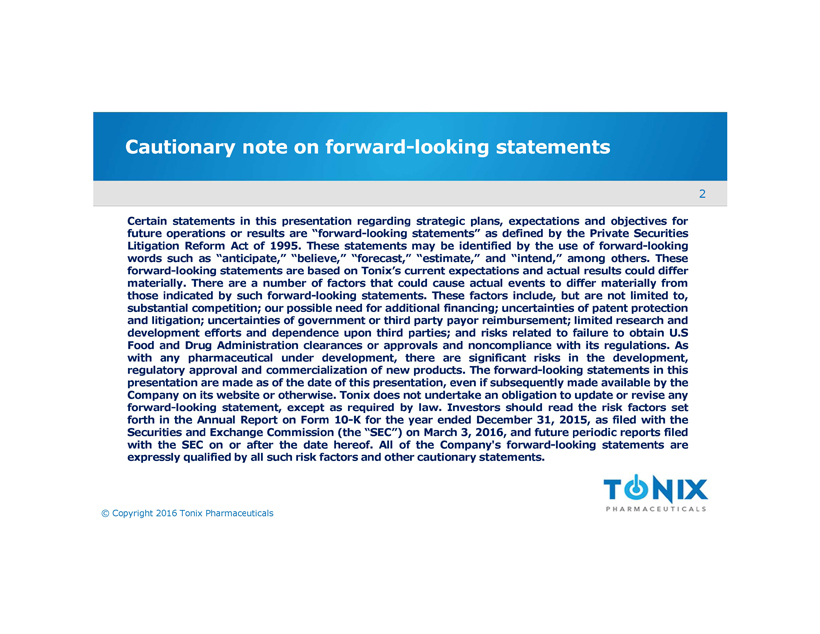
2 © Copyright 2016 Tonix Pharmaceuticals Cautionary note on forward - looking statements Certain statements in this presentation regarding strategic plans, expectations and objectives for future operations or results are “forward - looking statements” as defined by the Private Securities Litigation Reform Act of 1995 . These statements may be identified by the use of forward - looking words such as “anticipate,” “believe,” “forecast,” “estimate,” and “intend,” among others . These forward - looking statements are based on Tonix’s current expectations and actual results could differ materially . There are a number of factors that could cause actual events to differ materially from those indicated by such forward - looking statements . These factors include, but are not limited to, substantial competition ; our possible need for additional financing ; uncertainties of patent protection and litigation ; uncertainties of government or third party payor reimbursement ; limited research and development efforts and dependence upon third parties ; and risks related to failure to obtain U . S Food and Drug Administration clearances or approvals and noncompliance with its regulations . As with any pharmaceutical under development, there are significant risks in the development, regulatory approval and commercialization of new products . The forward - looking statements in this presentation are made as of the date of this presentation, even if subsequently made available by the Company on its website or otherwise . Tonix does not undertake an obligation to update or revise any forward - looking statement, except as required by law . Investors should read the risk factors set forth in the Annual Report on Form 10 - K for the year ended December 31 , 2015 , as filed with the Securities and Exchange Commission (the “SEC”) on March 3 , 2016 , and future periodic reports filed with the SEC on or after the date hereof . All of the Company's forward - looking statements are expressly qualified by all such risk factors and other cautionary statements .
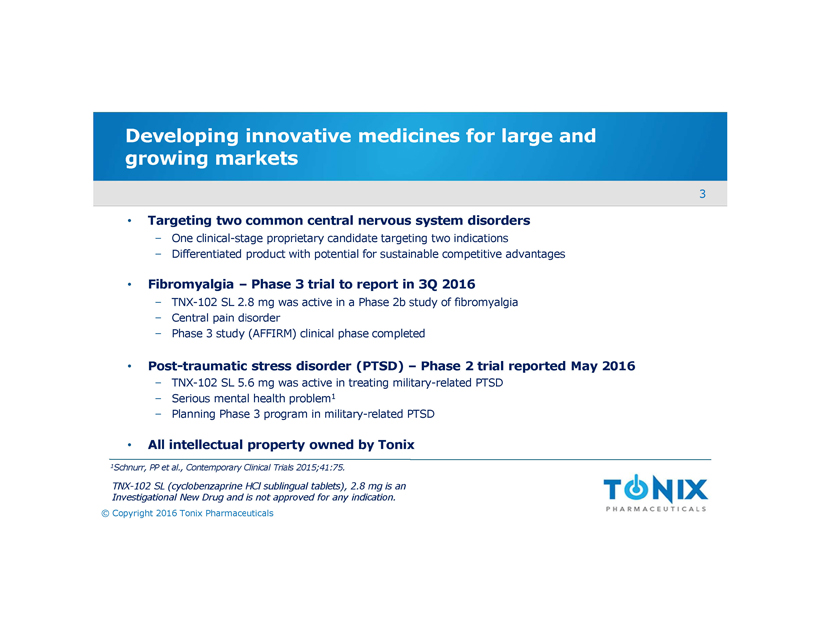
3 © Copyright 2016 Tonix Pharmaceuticals Developing innovative medicines for large and growing markets • Targeting two common central nervous system disorders ‒ One clinical - stage proprietary candidate targeting two indications ‒ Differentiated product with potential for sustainable competitive advantages • Fibromyalgia – Phase 3 trial to report in 3Q 2016 ‒ TNX - 102 SL 2.8 mg was active in a Phase 2b study of fibromyalgia ‒ Central pain disorder ‒ Phase 3 study (AFFIRM) clinical phase completed • Post - traumatic stress disorder (PTSD) – Phase 2 trial reported May 2016 ‒ TNX - 102 SL 5.6 mg was active in treating military - related PTSD ‒ Serious mental health problem 1 ‒ Planning Phase 3 program in military - related PTSD • All intellectual property owned by Tonix 1 Schnurr, PP et al., Contemporary Clinical Trials 2015;41:75. T NX - 102 SL (cyclobenzaprine HCl sublingual tablets), 2.8 mg is an Investigational New Drug and is not approved for any indication.

4 © Copyright 2016 Tonix Pharmaceuticals Candidate Indication Near - term Catalyst TNX - 102 SL 2.8 mg ( Tonmya ® *) Fibromyalgia Top line data 3Q 2016 TNX - 102 SL 5.6 mg Post - Traumatic Stress Disorder Phase 3 starting 1Q 2017 Pipeline led by TNX - 102 SL for fibromyalgia Preclinical Phase 1 Phase 2 Phase 3 NDA Market NDA = New Drug Application; FDA = U.S. Food and Drug Administration. * Tonmya ® has been conditionally accepted by the FDA as the proposed tradename of TNX - 102 SL for fibromyalgia.
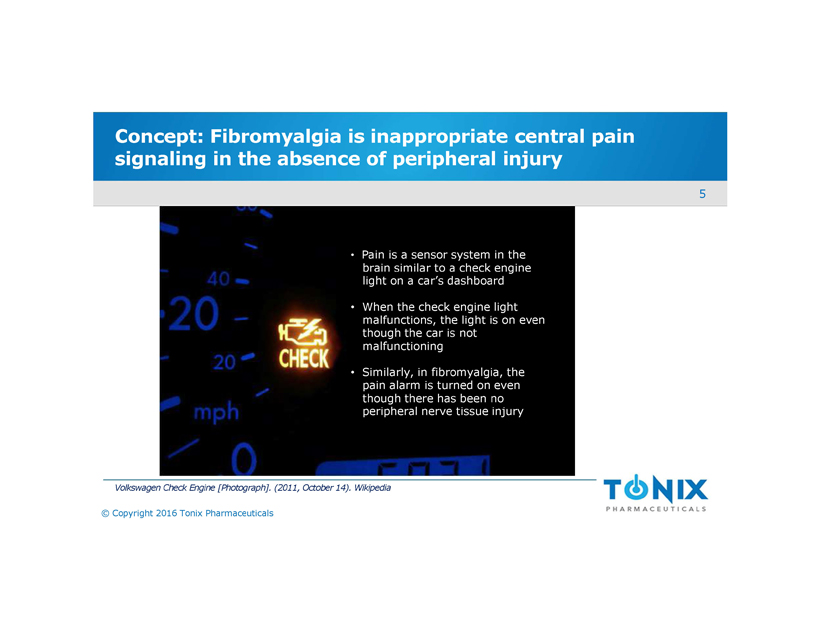
5 © Copyright 2016 Tonix Pharmaceuticals Concept: Fibromyalgia is inappropriate central pain signaling in the absence of peripheral injury Volkswagen Check Engine [Photograph]. (2011, October 14). Wikipedia • Pain is a sensor system in the brain similar to a check engine light on a car’s dashboard • When the check engine light malfunctions, the light is on even though the car is not malfunctioning • Similarly, in fibromyalgia, the pain alarm is turned on even though there has been no peripheral nerve tissue injury

6 © Copyright 2016 Tonix Pharmaceuticals Fibromyalgia is a chronic, debilitating disorder that imposes a significant societal and economic burden • Fibromyalgia is considered neurobiological disorder characterized by 1 : • Believed to result from amplified sensory and pain signaling in central nervous system 1 • Causes significant impairment in all areas of life 2 ‒ Lower levels of health - related quality of life – reduced daily functioning ‒ Interference with work (loss of productivity, disability) • Inflicts substantial strain on the healthcare system ‒ Average patient has 20 physician office visits per year 3 ‒ Annual direct medical costs are twice those for non - fibromyalgia individuals 4 1 Phillips K & Clauw DJ, Best Pract Res Clin Rheumatol 2011;25:141. 2 Schaefer et al., Pain Pract , 2015. 3 Robinson et al, Pain Medicine 2013;14:1400. 4 White et al, J Occupational Environ Med 2008;50:13. – Chronic widespread pain – Nonrestorative sleep – Fatigue – Diminished cognition
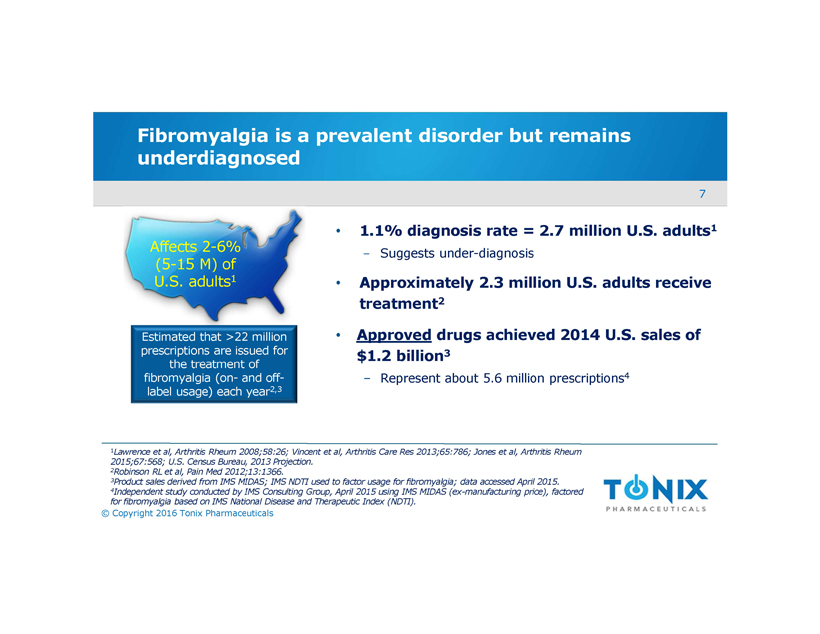
7 © Copyright 2016 Tonix Pharmaceuticals Fibromyalgia is a prevalent disorder but remains underdiagnosed 1 Lawrence et al, Arthritis Rheum 2008;58:26; Vincent et al, Arthritis Care Res 2013;65:786; Jones et al, Arthritis Rheum 2015;67:568; U.S. Census Bureau, 2013 Projection . 2 Robinson RL et al, Pain Med 2012;13:1366. 3 Product sales derived from IMS MIDAS; IMS NDTI used to factor usage for fibromyalgia; data accessed April 2015. 4 Independent study conducted by IMS Consulting Group, April 2015 using IMS MIDAS (ex - manufacturing price), factored for fibromyalgia based on IMS National Disease and Therapeutic Index (NDTI). Affects 2 - 6% (5 - 15 M) of U.S. adults 1 • 1.1% diagnosis rate = 2.7 million U.S. adults 1 ‒ Suggests under - diagnosis • Approximately 2.3 million U.S. adults receive treatment 2 • Approved drugs achieved 2014 U.S. sales of $1.2 billion 3 ‒ Represent about 5.6 million prescriptions 4 Estimated that >22 million prescriptions are issued for the treatment of fibromyalgia (on - and off - label usage) each year 2,3
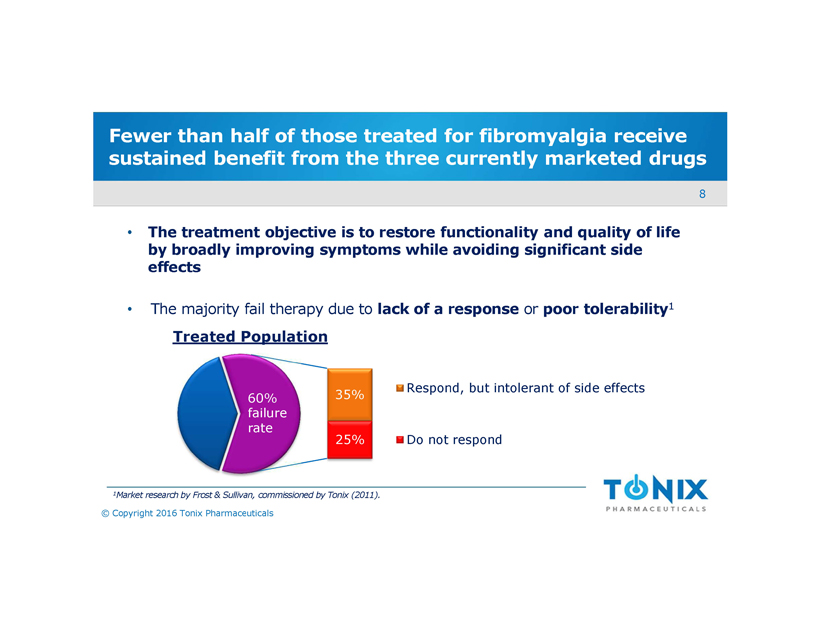
8 © Copyright 2016 Tonix Pharmaceuticals Fewer than half of those treated for fibromyalgia receive sustained benefit from the three currently marketed drugs • The treatment objective is to restore functionality and quality of life by broadly improving symptoms while avoiding significant side effects • The majority fail therapy due to lack of a response or poor tolerability 1 Respond, but intolerant of side effects Do not respond 25% 35% 60% failure rate 1 Market research by Frost & Sullivan, commissioned by Tonix (2011). Treated Population
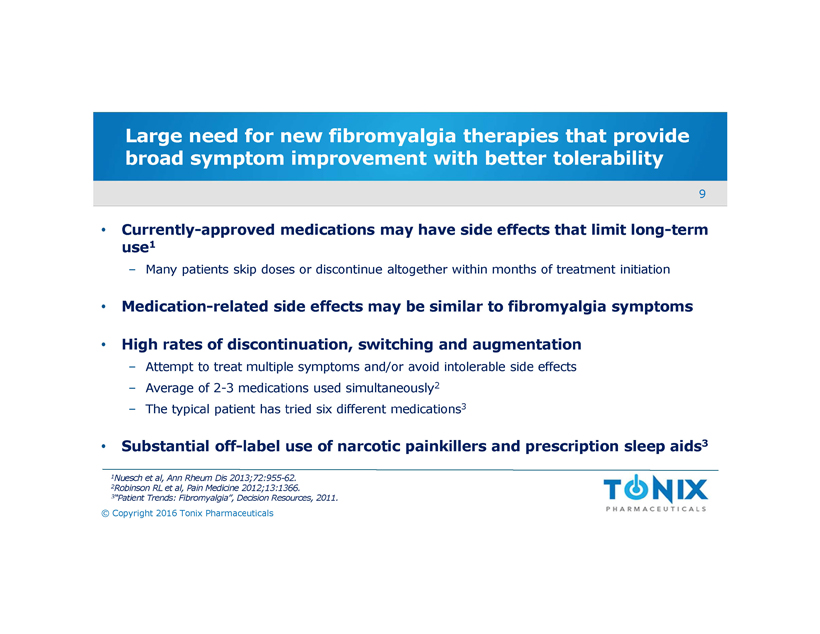
9 © Copyright 2016 Tonix Pharmaceuticals Large need for new fibromyalgia therapies that provide broad symptom improvement with better tolerability • Currently - approved medications may have side effects that limit long - term use 1 ‒ Many patients skip doses or discontinue altogether within months of treatment initiation • Medication - related side effects may be similar to fibromyalgia symptoms • High rates of discontinuation, switching and augmentation ‒ A ttempt to treat multiple symptoms and/or avoid intolerable side effects ‒ Average of 2 - 3 medications used simultaneously 2 ‒ The typical patient has tried six different medications 3 • Substantial off - label use of narcotic painkillers and prescription sleep aids 3 1 Nuesch et al, Ann Rheum Dis 2013;72:955 - 62. 2 Robinson RL et al, Pain Medicine 2012;13:1366. 3 “Patient Trends: Fibromyalgia”, Decision Resources, 2011.
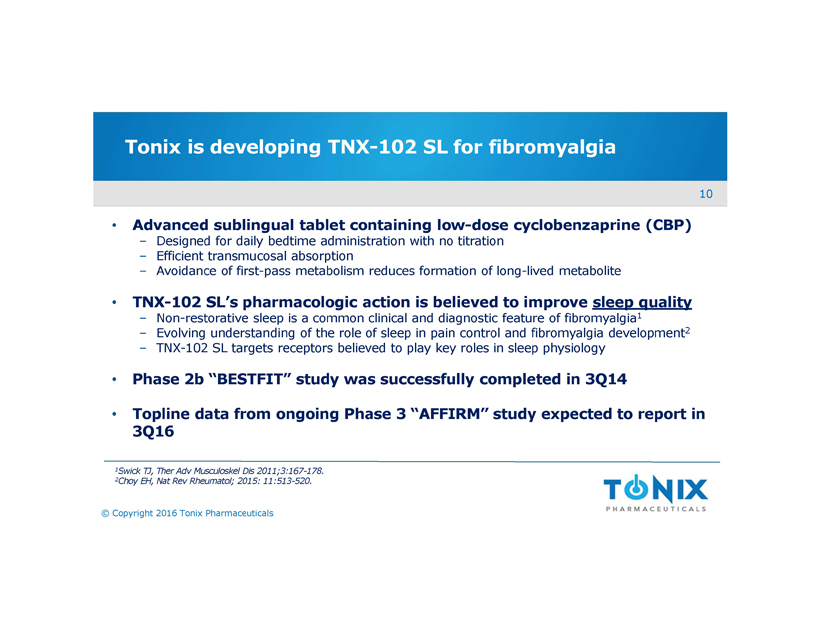
10 © Copyright 2016 Tonix Pharmaceuticals Tonix is developing TNX - 102 SL for fibromyalgia • Advanced sublingual tablet containing low - dose cyclobenzaprine (CBP) ‒ Designed for daily bedtime administration with no titration ‒ Efficient transmucosal absorption ‒ Avoidance of first - pass metabolism reduces formation of long - lived metabolite • TNX - 102 SL’s pharmacologic action is believed to improve sleep quality ‒ Non - restorative sleep is a common clinical and diagnostic feature of fibromyalgia 1 ‒ Evolving understanding of the role of sleep in pain control and fibromyalgia development 2 ‒ TNX - 102 SL targets receptors believed to play key roles in sleep physiology • Phase 2b “BESTFIT” study was successfully completed in 3Q14 • Topline data from ongoing Phase 3 “AFFIRM” study expected to report in 3Q16 1 Swick TJ, Ther Adv Musculoskel Dis 2011;3:167 - 178. 2 Choy EH, Nat Rev Rheumatol ; 2015: 11:513 - 520.
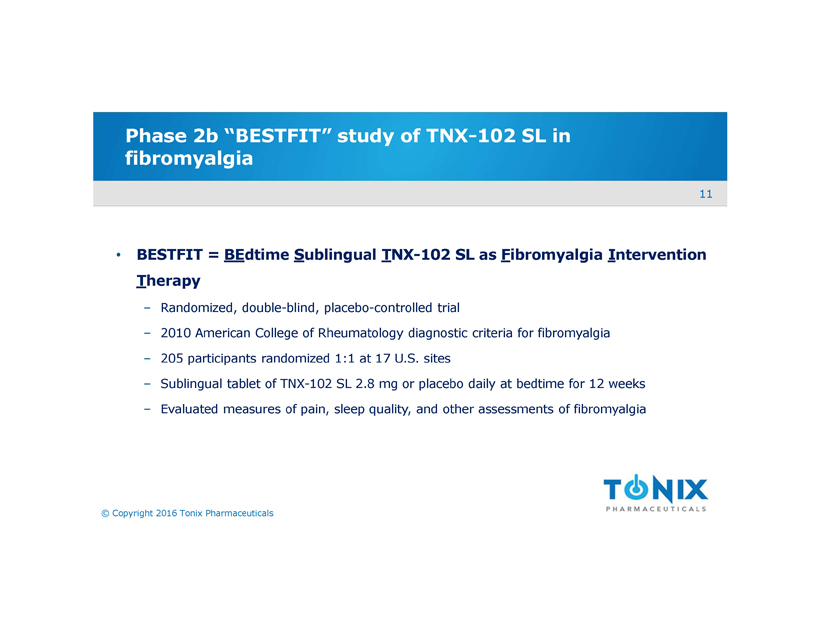
11 © Copyright 2016 Tonix Pharmaceuticals Phase 2b “BESTFIT” study of TNX - 102 SL in fibromyalgia • BESTFIT = BE dtime S ublingual T NX - 102 SL as F ibromyalgia I ntervention T herapy ‒ Randomized, double - blind, placebo - controlled trial ‒ 2010 American College of Rheumatology diagnostic criteria for fibromyalgia ‒ 205 participants randomized 1:1 at 17 U.S. sites ‒ Sublingual tablet of TNX - 102 SL 2.8 mg or placebo daily at bedtime for 12 weeks ‒ Evaluated measures of pain, sleep quality, and other assessments of fibromyalgia
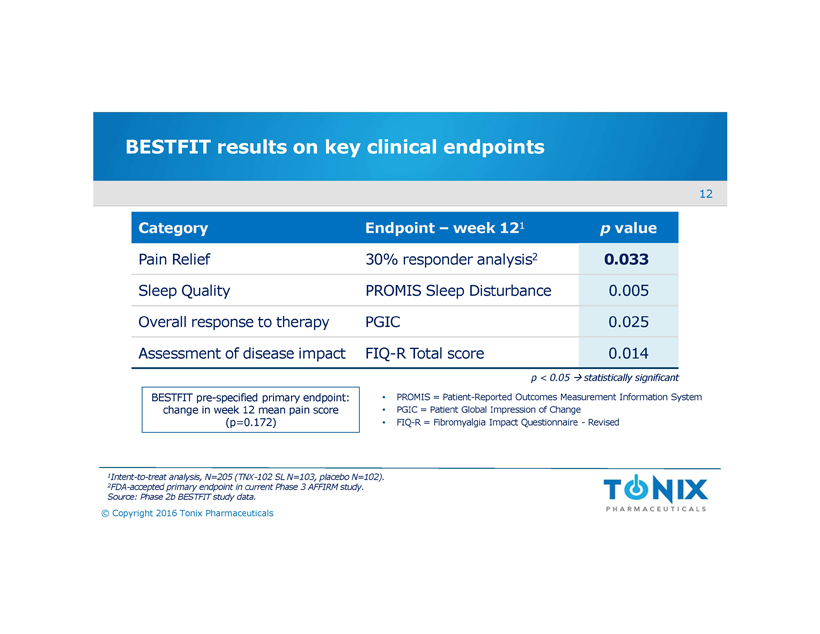
12 © Copyright 2016 Tonix Pharmaceuticals BESTFIT results on key clinical endpoints Category Endpoint – week 12 1 p value Pain Relief 30% responder analysis 2 0.033 Sleep Quality PROMIS Sleep Disturbance 0.005 Overal l response to therapy PGIC 0.025 Assessment of disease impact FIQ - R Total score 0.014 1 Intent - to - treat analysis, N=205 (TNX - 102 SL N=103, placebo N=102). 2 FDA - accepted primary endpoint in current Phase 3 AFFIRM study. Source: Phase 2b BESTFIT study data. BESTFIT pre - specified primary endpoint: change in week 12 mean pain score (p=0.172) • PROMIS = Patient - Reported Outcomes Measurement Information System • PGIC = Patient Global Impression of Change • FIQ - R = Fibromyalgia Impact Questionnaire - Revised p < 0.05 statistically significant

13 © Copyright 2016 Tonix Pharmaceuticals TNX - 102 SL safety and tolerability profile in the BESTFIT study • No serious adverse events (SAE) reported with TNX - 102 SL • Systemic adverse events reported by at least 3% of the total BESTFIT population • Most frequent local adverse events were administration site reactions ‒ Previously reported in Phase 1 studies; no detectable bias on efficacy results ‒ Transient tongue numbness (44% TNX - 102 SL vs. 2% placebo) ‒ Abnormal taste (8% TNX - 102 SL vs. 0% placebo) • Trial completion rates of 86% with TNX - 102 SL vs. 83% with placebo Source: Lederman et al., poster at American College of Rheumatology, 2015. TNX - 102 SL (N=103) Placebo (N=101) Total (N=204) Somnolence 1.9 6.9 4.4 Dry Mouth 3.9 4.0 3.9 Back Pain 4.9 3.0 3.9 Nausea 4.9 2.0 3.4 Sinusitis 3.9 3.0 3.4
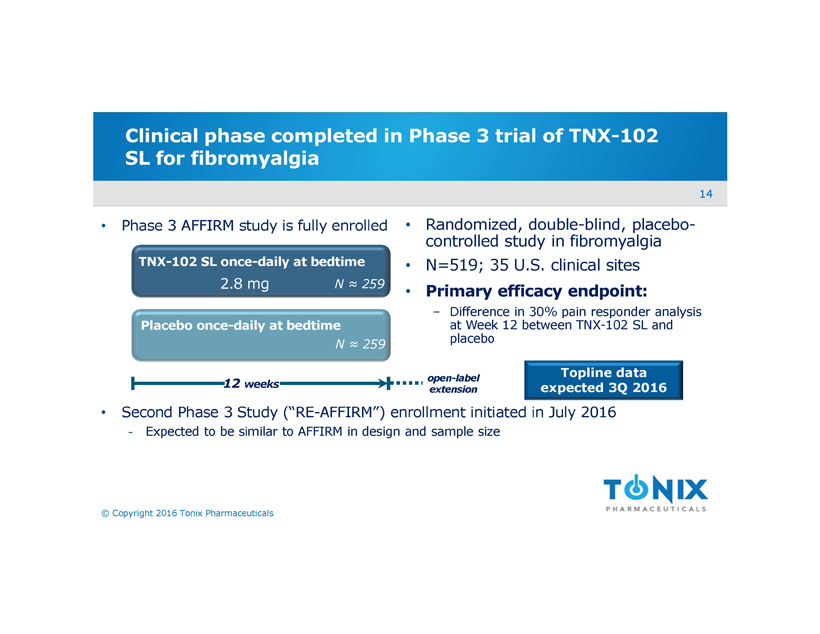
14 © Copyright 2016 Tonix Pharmaceuticals • Phase 3 AFFIRM study is fully enrolled • Second Phase 3 Study (“RE - AFFIRM”) enrollment initiated in July 2016 - Expected to be similar to AFFIRM in design and sample size Clinical phase completed in Phase 3 trial of TNX - 102 SL for fibromyalgia • Randomized, double - blind, placebo - controlled study in fibromyalgia • N=519; 35 U.S. clinical sites • Primary efficacy endpoint: ‒ Difference in 30% pain responder analysis at Week 12 between TNX - 102 SL and placebo Placebo once - daily at bedtime 12 weeks TNX - 102 SL once - daily at bedtime N ≈ 259 N ≈ 259 2.8 mg open - label extension Topline data expected 3Q 2016

15 © Copyright 2016 Tonix Pharmaceuticals TNX - 102 SL in Phase 2 development for PTSD Phase 1 Phase 2 Phase 3 NDA * Tonmya ® has been conditionally accepted by the FDA as the proposed tradename of TNX - 102 SL for fibromyalgia. Candidate Indication Near - term Catalyst TNX - 102 SL ( Tonmya ® *) 2.8 mg Fibromyalgia Top line data 3Q 2016 TNX - 102 SL 5.6 mg Post - Traumatic Stress Disorder Phase 3 Starting 1Q 2017 Preclinical Phase 1 Phase 2 Phase 3 NDA Market

16 © Copyright 2016 Tonix Pharmaceuticals PTSD is a chronic stress disorder triggered by a traumatic event • PTSD is characterized by: • Considered a stress response, but prolonged and does not resolve with time ‒ 20% of women and 8% of men who experience significant trauma develop PTSD 1 • Associated with significant life disruption ‒ Social isolation, inability to maintain employment, loss of independent living ‒ Unpredictable acts of violence, suicidal thoughts – re - experiencing the triggering event – negative alterations in mood/cognition – situation/stimulus avoidance – hyperarousal (anxiety, agitation & sleep disturbance) 1 Kessler et al, Arch Gen Psychiatry 1995;52:1048.
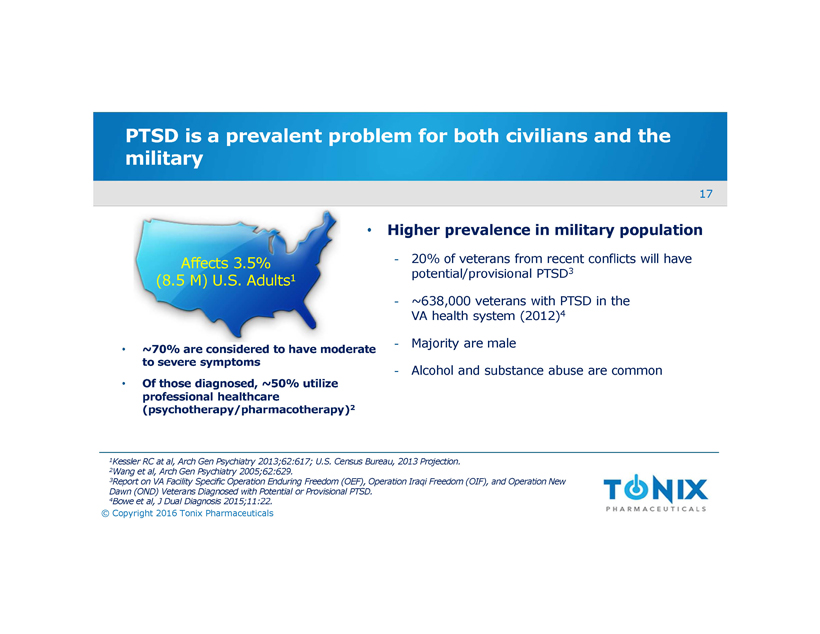
17 © Copyright 2016 Tonix Pharmaceuticals PTSD is a prevalent problem for both civilians and the military • ~70% are considered to have moderate to severe symptoms • Of those diagnosed, ~50% utilize professional healthcare (psychotherapy/pharmacotherapy) 2 1 Kessler RC at al, Arch Gen Psychiatry 2013;62:617; U.S. Census Bureau, 2013 Projection. 2 Wang et al, Arch Gen Psychiatry 2005;62:629. 3 Report on VA Facility Specific Operation Enduring Freedom (OEF), Operation Iraqi Freedom (OIF), and Operation New Dawn (OND) Veterans Diagnosed with Potential or Provisional PTSD. 4 Bowe et al, J Dual Diagnosis 2015;11:22. Affects 3.5% (8.5 M) U.S. Adults 1 • Higher prevalence in military population - 20% of veterans from recent conflicts will have potential/provisional PTSD 3 - ~638,000 veterans with PTSD in the VA health system (2012) 4 - Majority are male - Alcohol and substance abuse are common

18 © Copyright 2016 Tonix Pharmaceuticals Limitations of current FDA - approved pharmacotherapies for military - related PTSD • No treatment response observed in U.S. military population ‒ Sertraline: negative large multicenter trial in U.S. military veterans 1 ‒ Placebo numerically superior on CAPS - 2 ‒ Paroxetine: not studied in military population • Inconsistent treatment response observed in males ‒ Sertraline: FDA - conducted post - hoc analysis concluded no effect for male civilian subgroup 2 ‒ Paroxetine: no gender - related difference in treatment outcome 3 • Important tolerability issues with SSRIs in this population ‒ Sexual dysfunction ‒ Insomnia SSRI: Selective Serotonin Reuptake Inhibitor. 1 Friedman MJ et al. J Clin Psychiatry 2007;68:711 - 20. 2 Zoloft® Package Insert, Pfizer, August 2014. 3 Paxil® Package Insert, Glaxo, June 2014.
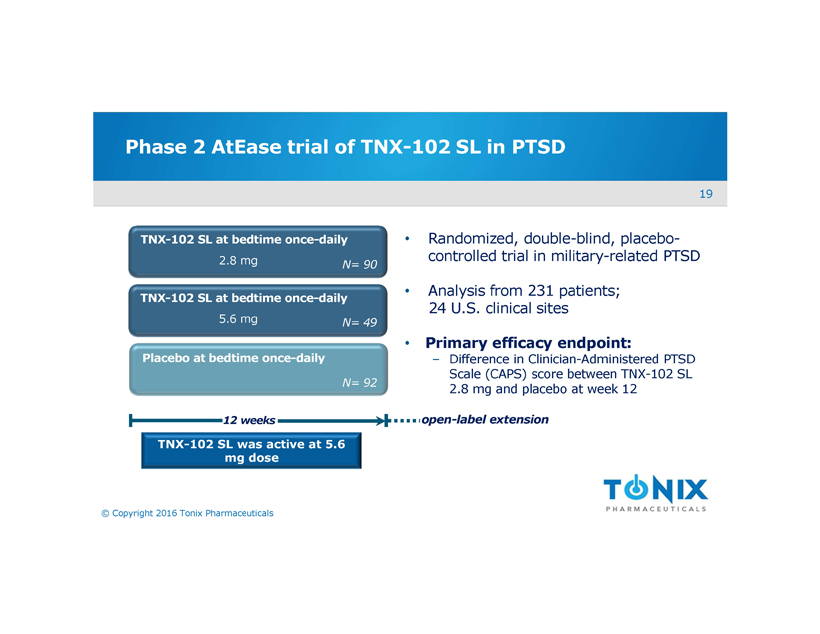
19 © Copyright 2016 Tonix Pharmaceuticals Phase 2 AtEase trial of TNX - 102 SL in PTSD • Randomized, double - blind, placebo - controlled trial in military - related PTSD • Analysis from 231 patients; 24 U.S. clinical sites • Primary efficacy endpoint: ‒ Difference in Clinician - Administered PTSD Scale (CAPS) score between TNX - 102 SL 2.8 mg and placebo at week 12 TNX - 102 SL was active at 5.6 mg dose TNX - 102 SL at bedtime once - daily Placebo at bedtime once - daily 12 weeks N= 90 TNX - 102 SL at bedtime once - daily N= 92 N= 49 2.8 mg 5.6 mg open - label extension
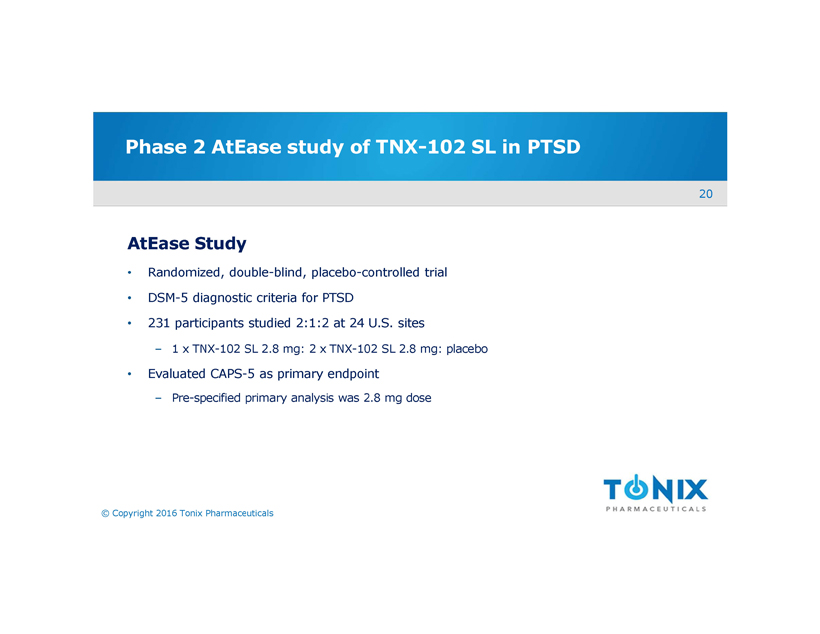
20 © Copyright 2016 Tonix Pharmaceuticals Phase 2 AtEase study of TNX - 102 SL in PTSD AtEase Study • Randomized, double - blind, placebo - controlled trial • DSM - 5 diagnostic criteria for PTSD • 231 participants studied 2:1:2 at 24 U.S. sites ‒ 1 x TNX - 102 SL 2.8 mg: 2 x TNX - 102 SL 2.8 mg: placebo • Evaluated CAPS - 5 as primary endpoint ‒ Pre - specified primary analysis was 2.8 mg dose
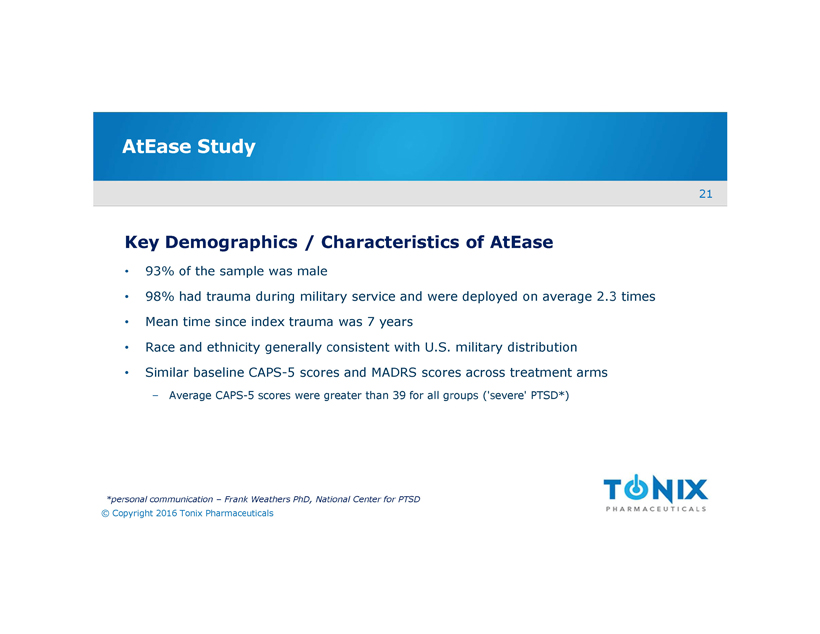
21 © Copyright 2016 Tonix Pharmaceuticals AtEase Study Key Demographics / Characteristics of AtEase • 93% of the sample was male • 98% had trauma during military service and were deployed on average 2.3 times • Mean time since index trauma was 7 years • Race and ethnicity generally consistent with U.S. military distribution • Similar baseline CAPS - 5 scores and MADRS scores across treatment arms ‒ Average CAPS - 5 scores were greater than 39 for all groups ('severe' PTSD*) *personal communication – Frank Weathers PhD, National Center for PTSD
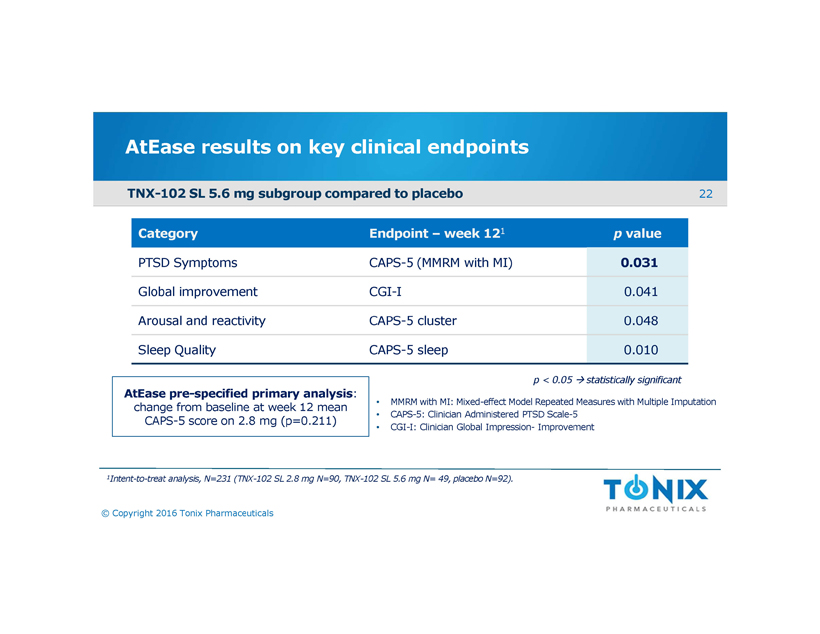
22 © Copyright 2016 Tonix Pharmaceuticals AtEase results on key clinical endpoints Category Endpoint – week 12 1 p value PTSD Symptoms CAPS - 5 (MMRM with MI) 0.031 Global improvement CGI - I 0.041 Arousal and reactivity CAPS - 5 cluster 0.048 Sleep Quality CAPS - 5 sleep 0.010 AtEase pre - specified primary analysis : change from baseline at week 12 mean CAPS - 5 score on 2.8 mg (p=0.211) • MMRM with MI: Mixed - effect Model Repeated Measures with Multiple Imputation • CAPS - 5: Clinician Administered PTSD Scale - 5 • CGI - I: Clinician Global Impression - Improvement p < 0.05 statistically significant 1 Intent - to - treat analysis, N=231 (TNX - 102 SL 2.8 mg N=90, TNX - 102 SL 5.6 mg N= 49, placebo N=92). TNX - 102 SL 5.6 mg subgroup compared to placebo
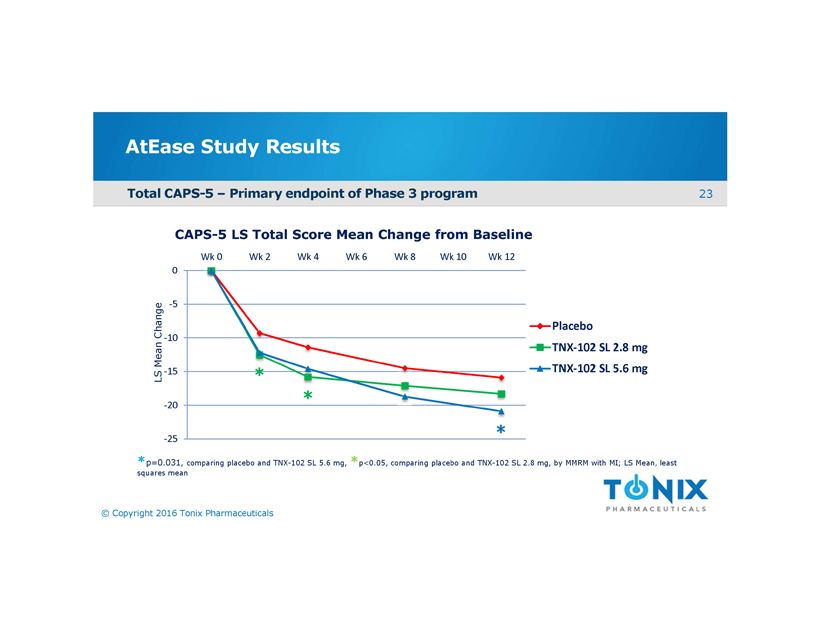
23 © Copyright 2016 Tonix Pharmaceuticals AtEase Study Results -25 -20 -15 -10 -5 0 Wk 0 Wk 2 Wk 4 Wk 6 Wk 8 Wk 10 Wk 12 Placebo TNX-102 SL 2.8 mg TNX-102 SL 5.6 mg * * p=0.031 , comparing placebo and TNX - 102 SL 5.6 mg, * p<0.05, comparing placebo and TNX - 102 SL 2.8 mg, by MMRM with MI; LS Mean, least squares mean LS Mean Change * * CAPS - 5 LS Total Score Mean Change from Baseline Total CAPS - 5 – Primary endpoint of Phase 3 program
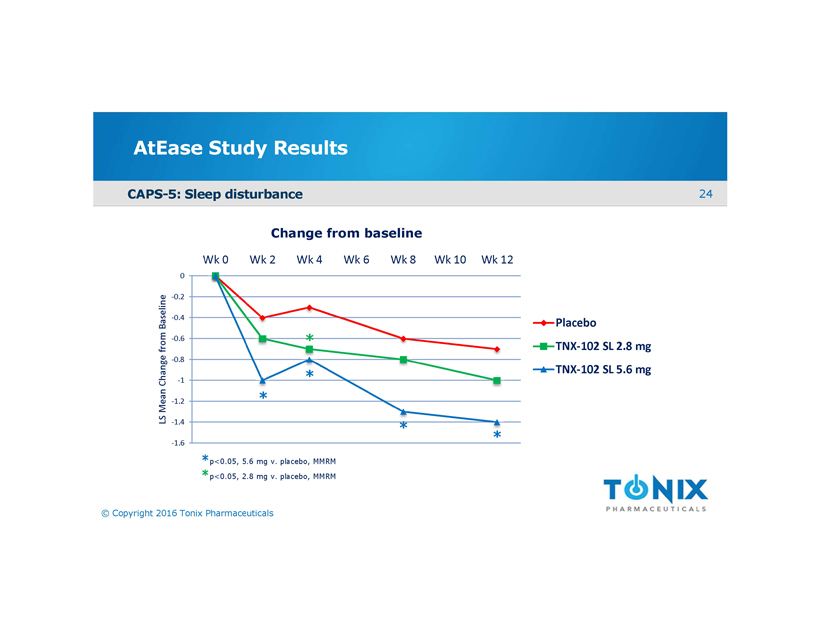
24 © Copyright 2016 Tonix Pharmaceuticals AtEase Study Results -1.6 -1.4 -1.2 -1 -0.8 -0.6 -0.4 -0.2 0 Wk 0 Wk 2 Wk 4 Wk 6 Wk 8 Wk 10 Wk 12 LS Mean Change from Baseline Placebo TNX-102 SL 2.8 mg TNX-102 SL 5.6 mg Change from baseline * * * * * p<0.05, 5.6 mg v. placebo, MMRM * p<0.05, 2.8 mg v. placebo, MMRM * CAPS - 5: Sleep disturbance
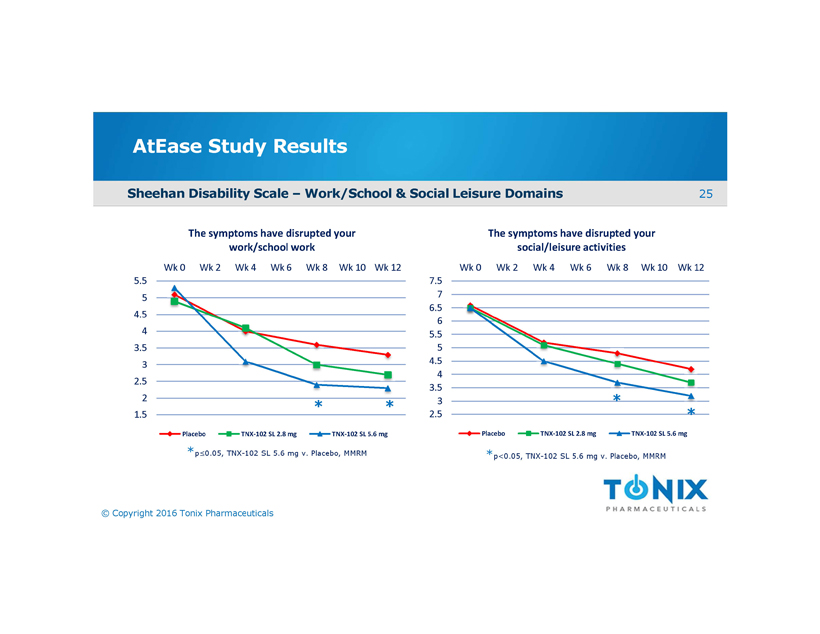
25 © Copyright 2016 Tonix Pharmaceuticals AtEase Study Results 1.5 2 2.5 3 3.5 4 4.5 5 5.5 Wk 0 Wk 2 Wk 4 Wk 6 Wk 8 Wk 10 Wk 12 The symptoms have disrupted your work/school work Placebo TNX-102 SL 2.8 mg TNX-102 SL 5.6 mg 2.5 3 3.5 4 4.5 5 5.5 6 6.5 7 7.5 Wk 0 Wk 2 Wk 4 Wk 6 Wk 8 Wk 10 Wk 12 The symptoms have disrupted your social/leisure activities Placebo TNX-102 SL 2.8 mg TNX-102 SL 5.6 mg * * * * * p≤0.05, TNX - 102 SL 5.6 mg v. Placebo, MMRM * p<0.05, TNX - 102 SL 5.6 mg v. Placebo, MMRM Sheehan Disability Scale – Work/School & Social Leisure Domains
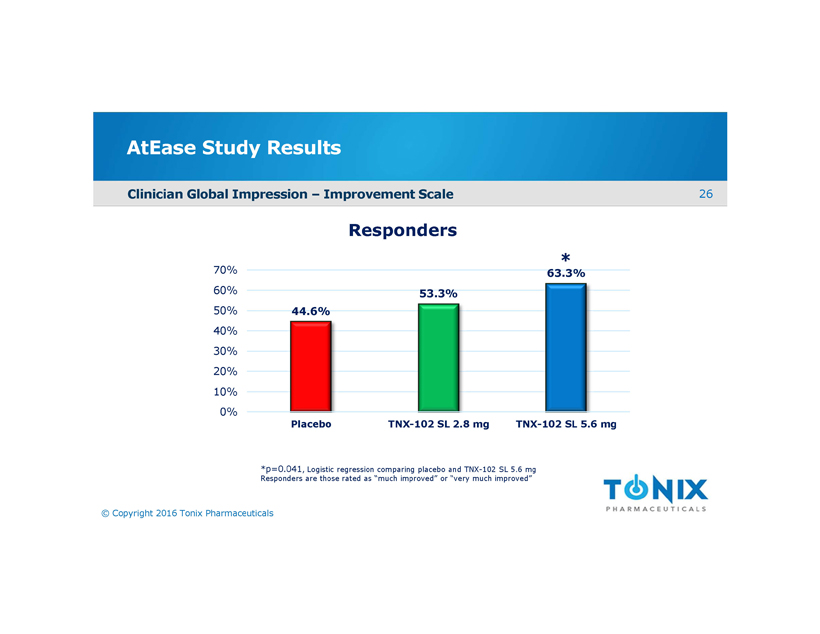
26 © Copyright 2016 Tonix Pharmaceuticals AtEase Study Results 44.6% 53.3% 63.3% 0% 10% 20% 30% 40% 50% 60% 70% Placebo TNX-102 SL 2.8 mg TNX-102 SL 5.6 mg * *p=0.041 , Logistic regression comparing placebo and TNX - 102 SL 5.6 mg Responders are those rated as “much improved” or “very much improved” Responders Clinician Global Impression – Improvement Scale
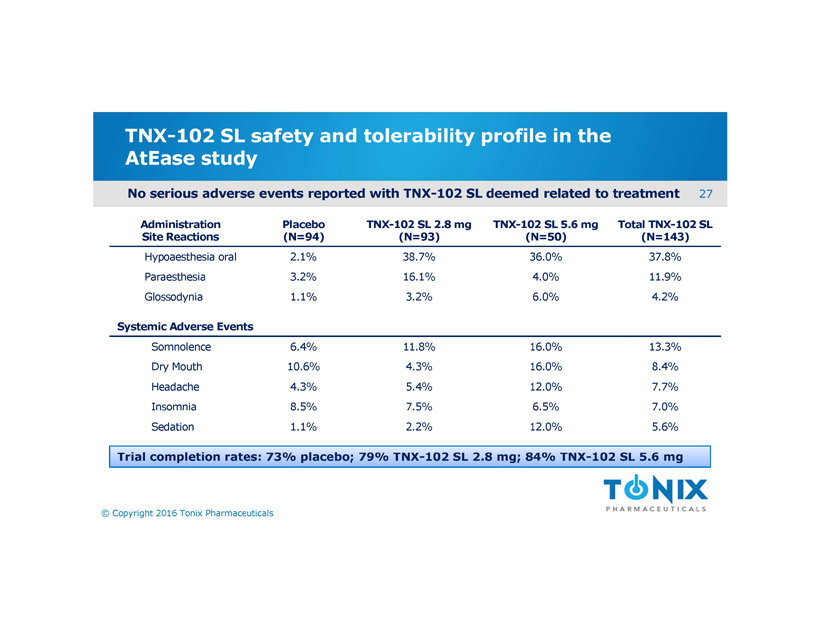
27 © Copyright 2016 Tonix Pharmaceuticals TNX - 102 SL safety and tolerability profile in the AtEase study No serious adverse events reported with TNX - 102 SL deemed related to treatment Administration Site Reactions Placebo (N=94) TNX - 102 SL 2.8 mg (N=93) TNX - 102 SL 5.6 mg (N=50) Total TNX - 102 SL (N=143) Hypoaesthesia oral 2.1% 38.7% 36.0% 37.8% Paraesthesia 3.2% 16.1% 4.0% 11.9% Glossodynia 1.1% 3.2% 6.0% 4.2% Systemic Adverse Events Somnolence 6.4% 11.8% 16.0% 13.3% Dry Mouth 10.6% 4.3% 16.0% 8.4% Headache 4.3% 5.4% 12.0% 7.7% Insomnia 8.5% 7.5% 6.5% 7.0% Sedation 1.1% 2.2% 12.0% 5.6% Trial completion rates: 73% placebo; 79% TNX - 102 SL 2.8 mg; 84% TNX - 102 SL 5.6 mg
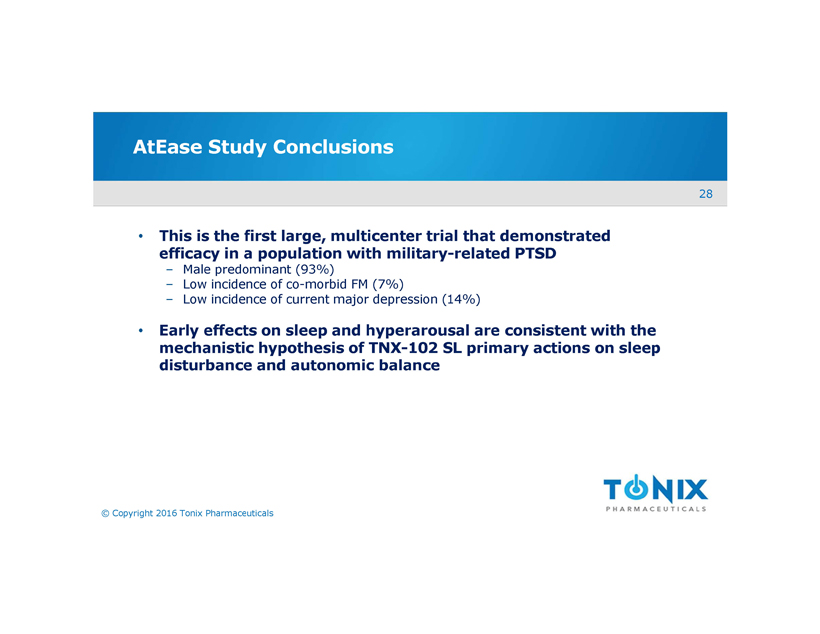
28 © Copyright 2016 Tonix Pharmaceuticals AtEase Study Conclusions • This is the first large, multicenter trial that demonstrated efficacy in a population with military - related PTSD ‒ Male predominant (93%) ‒ Low incidence of co - morbid FM (7%) ‒ Low incidence of current major depression (14%) • Early effects on sleep and hyperarousal are consistent with the mechanistic hypothesis of TNX - 102 SL primary actions on sleep disturbance and autonomic balance

29 © Copyright 2016 Tonix Pharmaceuticals Phase 3 program in PTSD being planned General Study Characteristics : • Randomized, double - blind, placebo - controlled study in PTSD • N~450; approximately 35 U.S. clinical sites Primary Efficacy Endpoint: • Difference in total CAPS - 5 analysis at Week 12 between TNX - 102 SL 5.6 mg and placebo Placebo once - daily at bedtime 12 weeks TNX - 102 SL once - daily at bedtime N ~ 225 N ~ 225 5.6 mg open - label extension Topline data for Phase 3 in military - related PSTD study anticipated 1H 2018 Planning to repeat AtEase in military - related PSTD: • Larger study • Targeting start in 1Q 2017

30 © Copyright 2016 Tonix Pharmaceuticals Intellectual property • Composition - of - matter (eutectic) ‒ Patents filed ‒ Protection expected to 2034 • Pharmacokinetics (PK) ‒ Patents filed ‒ Protection expected to 2033 • Method - of - use ‒ Fibromyalgia : patents issued, 2020 expiry ‒ PTSD: patents filed TNX - 102 SL Fibromyalgia , PTSD Wholly - owned by Tonix with no obligations to others
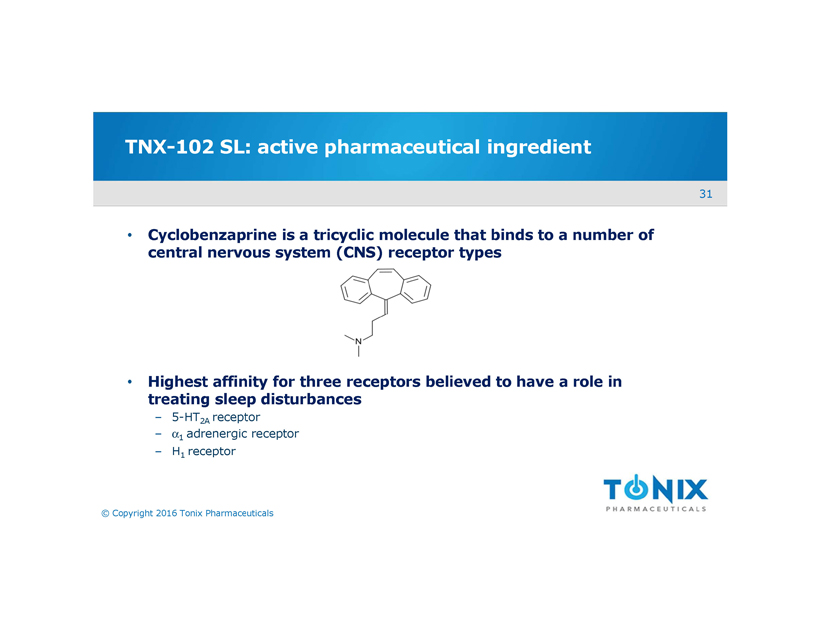
31 © Copyright 2016 Tonix Pharmaceuticals TNX - 102 SL: active pharmaceutical ingredient • Cyclobenzaprine is a tricyclic molecule that binds to a number of central nervous system (CNS) receptor types • Highest affinity for three receptors believed to have a role in treating sleep disturbances ‒ 5 - HT 2A receptor ‒ a 1 adrenergic receptor ‒ H 1 receptor
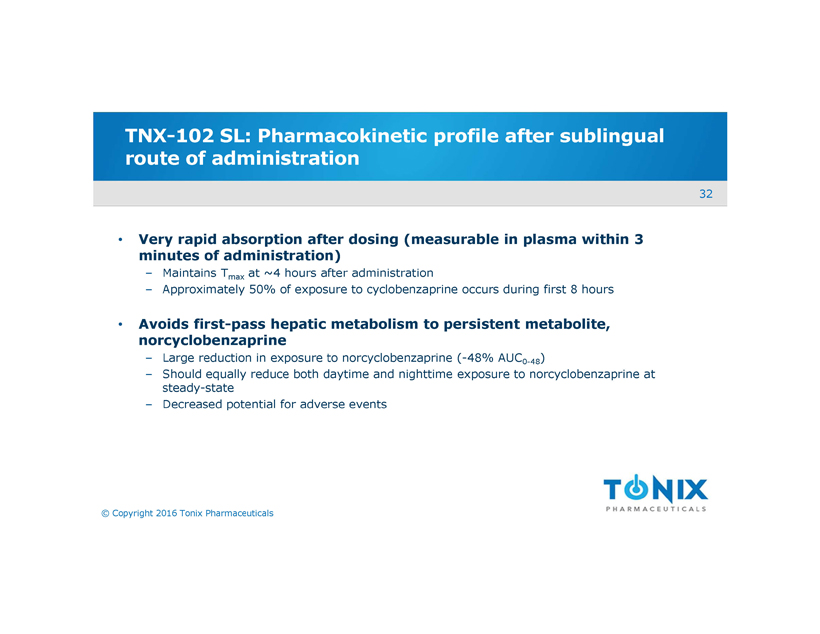
32 © Copyright 2016 Tonix Pharmaceuticals TNX - 102 SL: Pharmacokinetic profile after sublingual route of administration • Very rapid absorption after dosing (measurable in plasma within 3 minutes of administration) ‒ Maintains T max at ~4 hours after administration ‒ Approximately 50% of exposure to cyclobenzaprine occurs during first 8 hours • Avoids first - pass hepatic metabolism to persistent metabolite, norcyclobenzaprine ‒ Large reduction in exposure to norcyclobenzaprine ( - 48% AUC 0 - 48 ) ‒ Should equally reduce both daytime and nighttime exposure to norcyclobenzaprine at steady - state ‒ Decreased potential for adverse events

33 © Copyright 2016 Tonix Pharmaceuticals Cyclobenzaprine is detected in plasma within minutes following sublingual TNX - 102 SL Plasma Concentration Versus Time of TNX - 102 SL Compared to oral Cyclobenzaprine IR 0 0.5 1.0 1.5 Concentration (ng/L) 2500 1500 1000 500 2000 0 TNX - 102 SL 2.8 mg (sublingual) Cyclobenzaprine IR 5 mg (oral) Time (h) Source: U.S. Patent applications 13/918,692 – Transmucosal absorption.
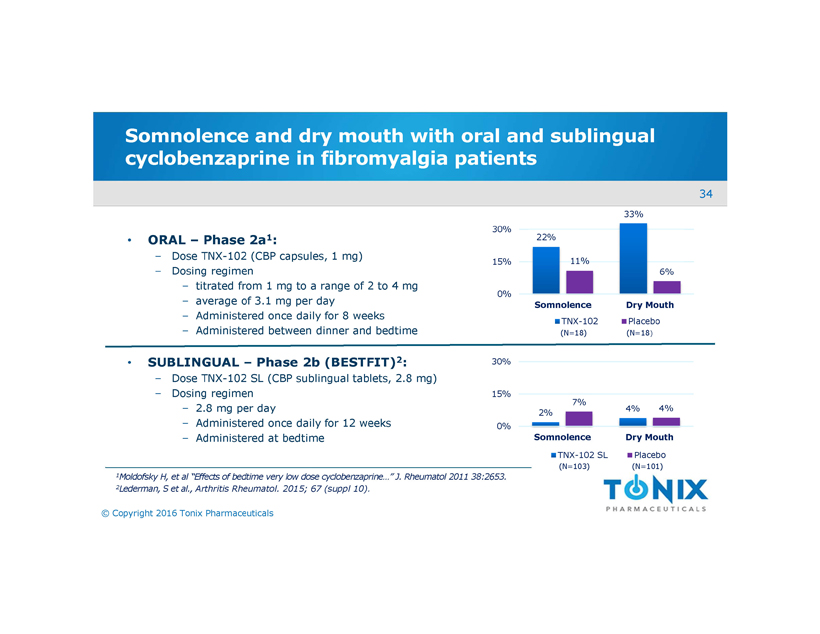
34 © Copyright 2016 Tonix Pharmaceuticals 2% 4% 7% 4% 0% 15% 30% Somnolence Dry Mouth TNX-102 SL Placebo Somnolence and dry mouth with oral and sublingual cyclobenzaprine in fibromyalgia patients • ORAL – Phase 2a 1 : ‒ Dose TNX - 102 (CBP capsules, 1 mg) ‒ Dosing regimen ‒ titrated from 1 mg to a range of 2 to 4 mg ‒ average of 3.1 mg per day ‒ Administered once daily for 8 weeks ‒ Administered between dinner and bedtime • SUBLINGUAL – Phase 2b (BESTFIT) 2 : ‒ Dose TNX - 102 SL (CBP sublingual tablets, 2.8 mg) ‒ Dosing regimen ‒ 2.8 mg per day ‒ Administered once daily for 12 weeks ‒ Administered at bedtime 1 Moldofsky H, et al “Effects of bedtime very low dose cyclobenzaprine…” J. Rheumatol 2011 38:2653. 2 Lederman, S et al., Arthritis Rheumatol . 2015; 67 ( suppl 10) . 22% 33% 11% 6% 0% 15% 30% Somnolence Dry Mouth TNX-102 Placebo (N=18) (N=18 ) (N=103) (N=101)
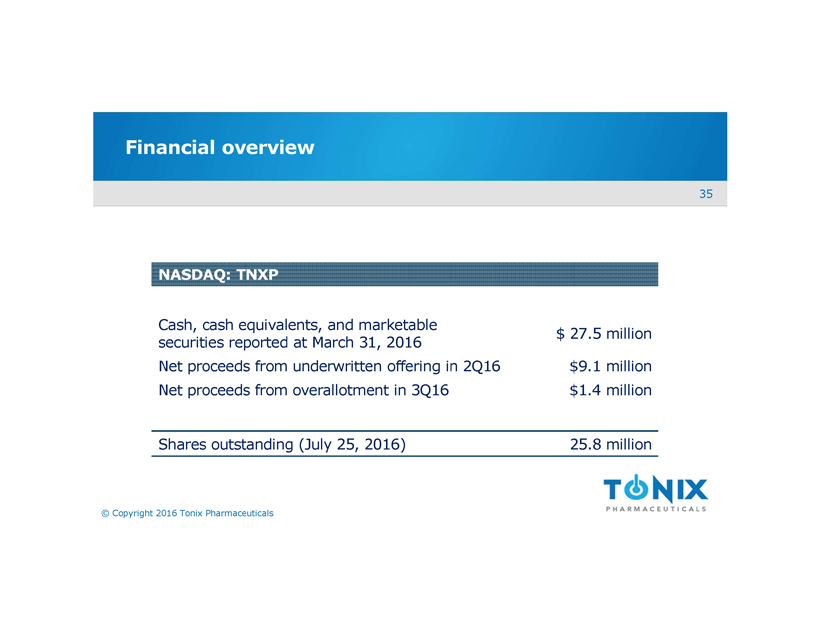
35 © Copyright 2016 Tonix Pharmaceuticals Financial overview NASDAQ: TNXP Cash, cash equivalents, and marketable securities reported at March 31, 2016 $ 27.5 million Net proceeds from underwritten offering in 2Q16 $9.1 million Net proceeds from overallotment in 3Q16 $1.4 million Shares outstanding (July 25, 2016) 25.8 million

36 © Copyright 2016 Tonix Pharmaceuticals Management team Seth Lederman, MD President & CEO Jessica Edgar Morris EVP, Administration Bruce Daugherty, PhD, MBA Chief Scientific Officer Ronald Notvest, PhD EVP, Commercial Planning & Development Gregory Sullivan, MD Chief Medical Officer Bradley Saenger, CPA Chief Financial Officer
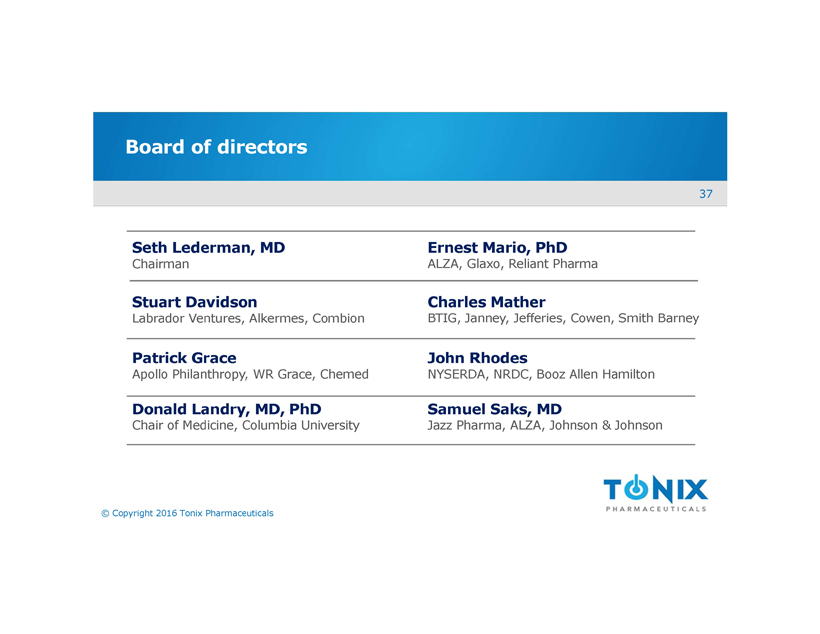
37 © Copyright 2016 Tonix Pharmaceuticals Board of directors Seth Lederman, MD Chairman Ernest Mario, PhD ALZA, Glaxo, Reliant Pharma John Rhodes NYSERDA, NRDC, Booz Allen Hamilton Samuel Saks, MD Jazz Pharma, ALZA, Johnson & Johnson Charles Mather BTIG, Janney, Jefferies, Cowen, Smith Barney Stuart Davidson Labrador Ventures, Alkermes , Combion Patrick Grace Apollo Philanthropy, WR Grace, Chemed Donald Landry, MD, PhD Chair of Medicine, Columbia University

38 © Copyright 2016 Tonix Pharmaceuticals Milestones – recent and upcoming TNX - 102 SL – Fibromyalgia □ May 2015 Began Phase 3 AFFIRM study □ November 2015 Presented additional data from Phase 2b BESTFIT study at ACR Meeting □ May 2016 Reported completion of enrollment in Phase 3 AFFIRM study □ July 2016 Commence enrollment of 2 nd Phase 3 RE - AFFIRM study □ Q3 2016 Report results from Phase 3 AFFIRM study TNX - 102 SL – Post - Traumatic Stress Disorder □ December 2015 Entered into Collaborative Research and Development Agreement (CRADA) with the United States Army Medical Materiel Development Activity (USAMMDA) □ December 2015 Reported completion of enrollment in Phase 2 AtEase study □ May 2016 Report results from AtEase study □ Q1 2017 Target commencement of Phase 3 study in PTSD x x x x x x x
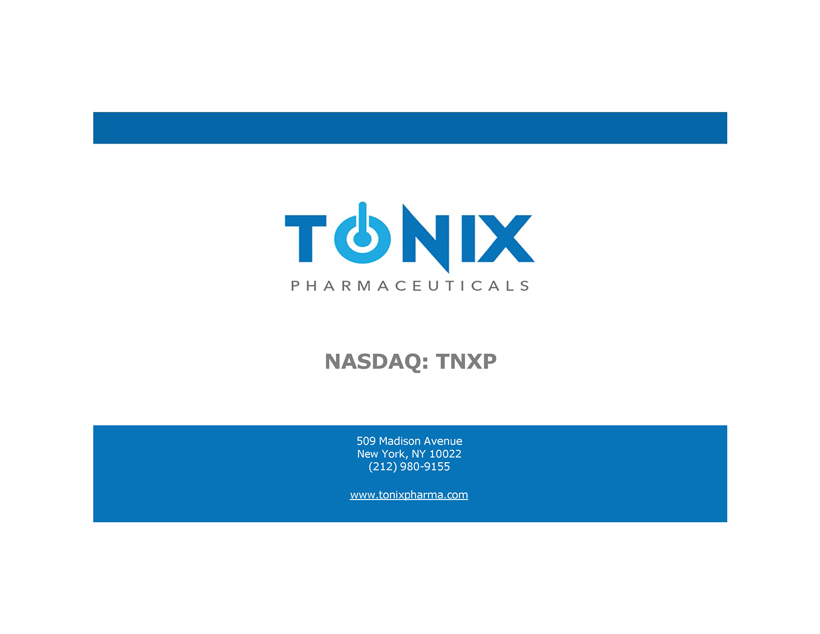
© Copyright 2016 Tonix Pharmaceuticals - Confidential - Do not duplicate or distribute NASDAQ: TNXP 509 Madison Avenue New York, NY 10022 (212) 980 - 9155 www.tonixpharma.com